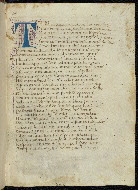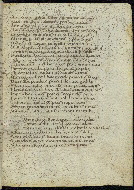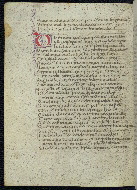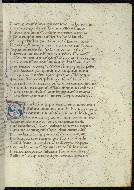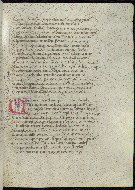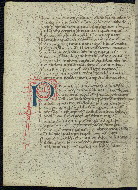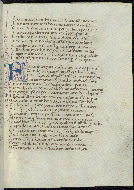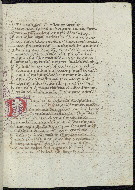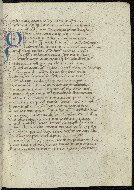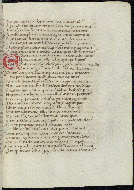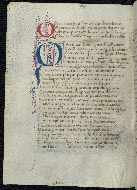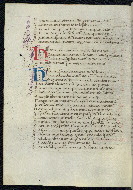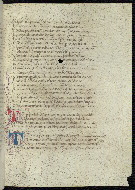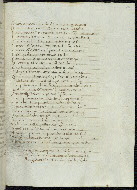Home > Digitized Walters Manuscripts
This document is a tranformation of a TEI P5 XML manuscript description incorporating images. If you have trouble reading special or non-Latin characters on this page, please make sure you have appropriate Unicode fonts installed and an up-to-date web browser.
Walters Ms. W.402, Virgil's Eclogues and Georgics
Browse images (Browse images in a new window) | TEI in XML format
W.402
Virgil's Eclogues and Georgics
Authority name: Virgil
Known as: Vergil
Known as: Vergilius Maro, Publius
Virgil, otherwise known as Publius Vergilius Maro (70 BCE-19 BCE), was a Roman poet who lived and worked during the reign of Emperor Augustus (63 BCE-14 CE). In addition to the Eclogues (or Bucolics) and the Georgics, he is best known for his epic poem The Aeneid. The Eclogues is composed of ten individual poems in dactylic hexameter, the meter used for all of Virgil's works. The structure and content of the Eclogues is based on Greek bucolic poetry, a genre created by the poet Theocritus, who lived in the third century BCE. Bucolic poetry is usually set in the country and highlights the pleasures of a simple, pastoral life. The Eclogues are adapted from this model but discuss Rome's turbulent history between 44 and 38 BCE after the death of Julius Caesar. The Georgics was produced ca. 29 BCE and is written in four books that focus on rural life and farming, extolling the benefits of country life, and taking many cues from the “Works and Days” by the Greek poet Hesiod (mid-eighth to mid-seventh century BCE). However, the text is also largely an allegorical commentary on the end of the Roman Republic and beginning of the Roman Empire in the mid to late first century BCE, a tumultuous time in the city's history. The parchment and decoration of the Walters version are fairly simple, and the text is heavily annotated, suggesting it served a student's textbook in the fifteenth century.
Ca. 1450 CE
Italy
Book
Literary -- Poetry
The primary language in this manuscript is Latin.
- Transliteration: Finis Bucolicorum
- Transliteration: Finis
Parchment
Somewhat rough, cream colored parchment; flesh sides especially porous
Foliation: i + 52 + ii
Modern pencil foliation, upper right corners, rectos
Formula: i + Quire 1: 8 (fols. 1-8); Quire 2: 8+1, with fol. 15 hooked onto fol. 11 (fols. 9-17); Quires 3-4: 10 (fols. 18-37); Quire 5: structure uncertain, with 9 fols. before stitching and 6 after; fol. 52 tipped in and appears to be glued to fol. 51; no text missing at end of book (fols. 38-52)
Catchwords: Written in lower, center margins, versos
Comments:
14.0 cm wide by 19.9 cm high
9.5 cm wide by 14.5 cm high
- Columns: 1
- Ruled lines: 32
- Title: Virgil's Eclogues and Georgics
- Author: Virgil
- Hand note: Humanist script
- Decoration note: Occasional decorated initials in blue or red ink, with added detail in purple or red pen work to divide up the text and designate individual poems; text in black ink
- Title: Eclogues
- Author: Virgil
- Incipit: Titire tu patulae recubans sub tegmine fagi [sic]
- Title: Georgics
- Author: Virgil
- Incipit: Quid faciat laetas segetes quo sidere terram
- Contents: Before the beginning of the text on fol. 14v there is a group of four unidentified lines similar to, but not matching, the incipit. This is the same for each of the four books. An excerpt from Book 2 has been inserted into Book 4, ending on fol. 52r where it transitions back to the correct text from Book 4. After the colophon on fol. 52r there are three inscriptions in two different hands, the first of which may refer to the ownership of the book by the monks of Santa Maria delle Grazie near Monteprandone after the death of San Giacomo della Marca (ca. 1391-1476), otherwise known as Jacob de Marchia or St. James of the Marches, O.F.M.
fol. 1r:
fol. 2r:
fol. 3v:
fol. 5r:
fol. 6r:
fol. 7v:
fol. 9r:
fol. 10r:
fol. 12r:
fol. 13r:
fol. 14v:
fol. 23v:
fol. 33r:
fol. 42r:
The binding is not original.
Eighteenth-century light brown sheep leather binding; gold-tooled floral border; possibly a thirteenth-century(?) palimpsest; antique laid paper flyleaves with a hand-shaped water mark (the wrist on one flyleaf, the fingers on another); the spine with gold tooling in seven compartments, the second reading "VIR / GIL / IUS;" repairs on fols. 11, 43, 46 and 52 with antique laid paper
Created in Italy ca. 1450
Purchased in the fifteenth century by the monks of Santa Maria della Grazie (near Monteprandone), who had inherited it in 1476 from San Giacomo della Marca (ca. 1391-1476) otherwise known as Jacob de Marchia or St. James of the Marches, O.F.M.
Leo S. Olschki, bookseller, Florence, ca. 1912
Henry Walters, Baltimore, purchased from Leo S. Olschki (inv. no 8619, written on first flyleaf, recto, in pencil; list, ca. 1912, no. 13)
Walters Art Museum, 1931, by Henry Walters' bequest
De Ricci, Seymour. Census of Medieval and Renaissance Manuscripts in the United States and Canada. Vol. 1. New York: H. W. Wilson Company, 1935, p. 832, no. 441.
Principal cataloger: Berlin, Nicole
Cataloger: Walters Art Museum curatorial staff and researchers since 1934
Editor: Herbert, Lynley
Copy editor: Dibble, Charles
Conservator: Quandt, Abigail
Contributors: Emery, Doug; Herbert, Lynley; Wiegand, Kimber
The Walters Art Museum
Licensed for use under Creative Commons Attribution-ShareAlike 3.0 Unported Access Rights, http://creativecommons.org/licenses/by-sa/3.0/legalcode. It is requested that copies of any published articles based on the information in this data set be sent to the curator of manuscripts, The Walters Art Museum, 600 North Charles Street, Baltimore MD 21201.
